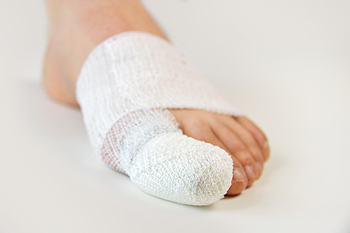Connect With Us
Blog
Reasons for Reconstructive Foot Surgery
 Foot reconstruction is a type of surgery that is performed to correct the anatomy of the foot and restore proper function. Someone might need reconstructive foot surgery following a major injury to the foot that affects the foot’s soft tissue or bones. Vascular diseases, which can interfere with circulation in the lower limbs, may require surgical intervention. Other issues which can cause deformities include metabolic diseases, such as diabetes and gout, that alter the blood and nerve supply of the foot, and tumors. Finally, birth defects such as clubfoot would also need to be corrected via reconstructive surgery. For more information on reconstructive foot surgery, please consult with a podiatrist.
Foot reconstruction is a type of surgery that is performed to correct the anatomy of the foot and restore proper function. Someone might need reconstructive foot surgery following a major injury to the foot that affects the foot’s soft tissue or bones. Vascular diseases, which can interfere with circulation in the lower limbs, may require surgical intervention. Other issues which can cause deformities include metabolic diseases, such as diabetes and gout, that alter the blood and nerve supply of the foot, and tumors. Finally, birth defects such as clubfoot would also need to be corrected via reconstructive surgery. For more information on reconstructive foot surgery, please consult with a podiatrist.
Foot surgery is sometimes necessary to treat a foot ailment. To learn more, contact Dr. Yeon A. Shim of Roselle Podiatry Group. Our doctor will assist you with all of your foot and ankle needs.
When Is Surgery Necessary?
Foot and ankle surgery is generally reserved for cases in which less invasive, conservative procedures have failed to alleviate the problem. Some of the cases in which surgery may be necessary include:
- Removing foot deformities like bunions and bone spurs
- Severe arthritis that has caused bone issues
- Cosmetic reconstruction
What Types of Surgery Are There?
The type of surgery you receive will depend on the nature of the problem you have. Some of the possible surgeries include:
- Bunionectomy for painful bunions
- Surgical fusion for realignment of bones
- Neuropathy decompression surgery to treat nerve damage
Benefits of Surgery
Although surgery is usually a last resort, it can provide more complete pain relief compared to non-surgical methods and may allow you to finally resume full activity.
Surgical techniques have also become increasingly sophisticated. Techniques like endoscopic surgery allow for smaller incisions and faster recovery times.
If you have any questions please feel free to contact our office located in Roselle, NJ . We offer the newest diagnostic and treatment technologies for all your foot and ankle needs.
What Can I Do About My Sweaty Feet?
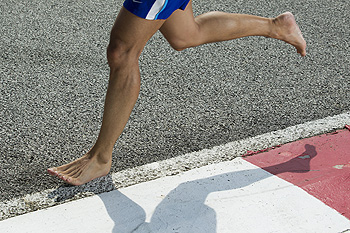 Plantar hyperhidrosis is a medical condition that causes excessively sweaty feet. All of this extra sweat is not only embarrassing, but can also lead to health complications. For example, it may increase your risk of injury due to your feet slipping and sliding in your shoes, or increase your risk of skin infections because of the constant moisture breaking down the skin on your feet. Fortunately, there are several treatments for plantar hyperhidrosis. A podiatrist may prescribe antiperspirants, which block the overactive sweat ducts. Botox injections into the feet, which can temporarily disable sweat glands, are also an effective treatment option. Iontophoresis, in which the feet are submerged in water with an electric current running through it, has been shown to reduce sweating as well. To learn more about plantar hyperhidrosis and to find the right treatment for you, please consult with a podiatrist.
Plantar hyperhidrosis is a medical condition that causes excessively sweaty feet. All of this extra sweat is not only embarrassing, but can also lead to health complications. For example, it may increase your risk of injury due to your feet slipping and sliding in your shoes, or increase your risk of skin infections because of the constant moisture breaking down the skin on your feet. Fortunately, there are several treatments for plantar hyperhidrosis. A podiatrist may prescribe antiperspirants, which block the overactive sweat ducts. Botox injections into the feet, which can temporarily disable sweat glands, are also an effective treatment option. Iontophoresis, in which the feet are submerged in water with an electric current running through it, has been shown to reduce sweating as well. To learn more about plantar hyperhidrosis and to find the right treatment for you, please consult with a podiatrist.
If you are suffering from hyperhidrosis contact Dr. Yeon A. Shim of Roselle Podiatry Group. Our doctor can provide the care you need to attend to all of your foot and ankle needs.
Hyperhidrosis of the Feet
Hyperhidrosis is a rare disorder that can cause people to have excessive sweating of their feet. This can usually occur all on its own without rigorous activity involved. People who suffer from hyperhidrosis may also experience sweaty palms.
Although it is said that sweating is a healthy process meant to cool down the body temperature and to maintain a proper internal temperature, hyperhidrosis may prove to be a huge hindrance on a person’s everyday life.
Plantar hyperhidrosis is considered to be the main form of hyperhidrosis. Secondary hyperhidrosis can refer to sweating that occurs in areas other than the feet or hands and armpits. Often this may be a sign of it being related to another medical condition such as menopause, hyperthyroidism and even Parkinson’s disease.
In order to alleviate this condition, it is important to see your doctor so that they may prescribe the necessary medications so that you can begin to live a normal life again. If this is left untreated, it is said that it will persist throughout an individual’s life.
A last resort approach would be surgery, but it is best to speak with your doctor to find out what may be the best treatment for you.
If you have any questions please feel free to contact our office located in Roselle, NJ . We offer the newest diagnostic and treatment technologies for all your foot and ankle needs.
Sources of Ankle Pain
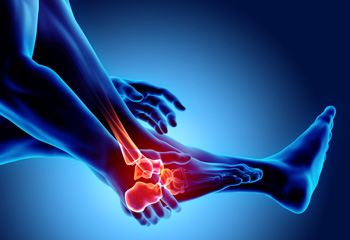 A common cause of ankle pain is a sprained ankle. This can cause limited mobility, and it is generally uncomfortable as the healing process occurs. Research has indicated that scar tissue can be a source of ankle pain, and this may originate from past ankle surgeries or injuries. Pain in the ankle that is intermittent can indicate a ligament tear, and may be accompanied by swelling. The ankle may be broken if a fall has occurred, and wearing a cast or walking boot may be required as it heals. If you are experiencing any type of ankle pain, it is strongly suggested that you consult with a podiatrist who can properly diagnose and treat any type of ankle pain.
A common cause of ankle pain is a sprained ankle. This can cause limited mobility, and it is generally uncomfortable as the healing process occurs. Research has indicated that scar tissue can be a source of ankle pain, and this may originate from past ankle surgeries or injuries. Pain in the ankle that is intermittent can indicate a ligament tear, and may be accompanied by swelling. The ankle may be broken if a fall has occurred, and wearing a cast or walking boot may be required as it heals. If you are experiencing any type of ankle pain, it is strongly suggested that you consult with a podiatrist who can properly diagnose and treat any type of ankle pain.
Ankle pain can have many different causes and the pain may potentially be serious. If you have ankle pain, consult with Dr. Yeon A. Shim from Roselle Podiatry Group. Our doctor will assess your condition and provide you with quality foot and ankle treatment.
Ankle pain is any condition that causes pain in the ankle. Due to the fact that the ankle consists of tendons, muscles, bones, and ligaments, ankle pain can come from a number of different conditions.
Causes
The most common causes of ankle pain include:
- Types of arthritis (rheumatoid, osteoarthritis, and gout)
- Ankle sprains
- Broken ankles
- Achilles tendinitis
- Achilles tendon rupture
- Stress fractures
- Tarsal tunnel syndrome
- Plantar fasciitis
Symptoms
Symptoms of ankle injury vary based upon the condition. Pain may include general pain and discomfort, swelling, aching, redness, bruising, burning or stabbing sensations, and/or loss of sensation.
Diagnosis
Due to the wide variety of potential causes of ankle pain, podiatrists will utilize a number of different methods to properly diagnose ankle pain. This can include asking for personal and family medical histories and of any recent injuries. Further diagnosis may include sensation tests, a physical examination, and potentially x-rays or other imaging tests.
Treatment
Just as the range of causes varies widely, so do treatments. Some more common treatments are rest, ice packs, keeping pressure off the foot, orthotics and braces, medication for inflammation and pain, and surgery.
If you have any questions, please feel free to contact our office located in Roselle, NJ . We offer the newest diagnostic and treatment technologies for all your foot care needs.
Do Your Child's Feet Hurt?
Rheumatoid Arthritis Is Associated With Many Foot Conditions
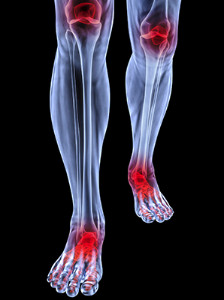 Rheumatoid arthritis is an autoimmune condition that causes inflammation in and damage to the joints. This condition tends to begin in the smaller joints of the hands and feet. Because of this, rheumatoid arthritis is often associated with a variety of foot conditions. Some of these include heel pain, bunions, hammertoes, flat feet, corns, and calluses. If you have rheumatoid arthritis and experience problems with your feet, it is recommended that you consult with a podiatrist. Receiving treatment can help reduce inflammation, relieve pain, and maintain mobility.
Rheumatoid arthritis is an autoimmune condition that causes inflammation in and damage to the joints. This condition tends to begin in the smaller joints of the hands and feet. Because of this, rheumatoid arthritis is often associated with a variety of foot conditions. Some of these include heel pain, bunions, hammertoes, flat feet, corns, and calluses. If you have rheumatoid arthritis and experience problems with your feet, it is recommended that you consult with a podiatrist. Receiving treatment can help reduce inflammation, relieve pain, and maintain mobility.
Because RA affects more than just your joints, including the joints in your feet and ankles, it is important to seek early diagnosis from your podiatrist if you feel like the pain in your feet might be caused by RA. For more information, contact Dr. Yeon A. Shim of Roselle Podiatry Group. Our doctor will assist you with all of your podiatric concerns.
What Is Rheumatoid Arthritis?
Rheumatoid Arthritis (RA) is an autoimmune disorder in which the body’s own immune system attacks the membranes surrounding the joints. Inflammation of the lining and eventually the destruction of the joint’s cartilage and bone occur, causing severe pain and immobility.
Rheumatoid Arthritis of the Feet
Although RA usually attacks multiple bones and joints throughout the entire body, almost 90 percent of cases result in pain in the foot or ankle area.
Symptoms
- Swelling and pain in the feet
- Stiffness in the feet
- Pain on the ball or sole of feet
- Joint shift and deformation
Diagnosis
Quick diagnosis of RA in the feet is important so that the podiatrist can treat the area effectively. Your doctor will ask you about your medical history, occupation, and lifestyle to determine the origin of the condition. Rheumatoid Factor tests help to determine if someone is affected by the disease.
If you have any questions please feel free to contact our office located in Roselle, NJ . We offer the newest diagnostic and treatment technologies for all your foot and ankle needs.
All About Broken Toes
The pain that is experienced with a broken toe can be debilitating. It may be difficult to walk, and any pressure that is exerted on the toe can cause severe pain and discomfort. A common cause of a broken toe is stubbing it against a piece of furniture. Additionally, if a heavy object is dropped on it, the result may be a fractured toe. Symptoms can include bruising of the toe and surrounding areas, and in severe cases, the toe may look deformed. In many cases effective treatment can consist of using a method that is referred to as buddy taping. This consists of taping the affected toe to the toe next to it, and this is often helpful in providing the stability that is necessary as the healing process occurs. If you feel you may have a broken toe, it is suggested that you confer with a podiatrist who can offer you correct treatment options.
Ingrown toenails can become painful if they are not treated properly. For more information about ingrown toenails, contact Dr. Yeon A. Shim of Roselle Podiatry Group. Our doctor can provide the care you need to keep you pain-free and on your feet.
Ingrown Toenails
Ingrown toenails occur when a toenail grows sideways into the bed of the nail, causing pain, swelling, and possibly infection.
Causes
- Bacterial infections
- Improper nail cutting such as cutting it too short or not straight across
- Trauma to the toe, such as stubbing, which causes the nail to grow back irregularly
- Ill-fitting shoes that bunch the toes too close together
- Genetic predisposition
Prevention
Because ingrown toenails are not something found outside of shoe-wearing cultures, going barefoot as often as possible will decrease the likeliness of developing ingrown toenails. Wearing proper fitting shoes and using proper cutting techniques will also help decrease your risk of developing ingrown toenails.
Treatment
Ingrown toenails are a very treatable foot condition. In minor cases, soaking the affected area in salt or antibacterial soaps will not only help with the ingrown nail itself, but also help prevent any infections from occurring. In more severe cases, surgery is an option. In either case, speaking to your podiatrist about this condition will help you get a better understanding of specific treatment options that are right for you.
If you have any questions please feel free to contact our office located in Roselle, NJ . We offer the newest diagnostic and treatment technologies for all your foot and ankle needs.
What Causes Foot Blisters?
 Blisters are fluid-filled bumps that form on the foot, typically in response to stress or trauma to the foot. A blister may be caused by excessive friction or irritation to the foot, as one might experience as a result of playing sports, wearing ill-fitting shoes, or having bones in the feet that are poorly aligned. Too much sun exposure and scalding burns may also cause blisters to form. Other potential causes of blisters are skin infections, such as Athlete’s Foot, and bug bites. Depending on their cause, some types of blisters can heal on their own, while others require medical intervention. Consult with a podiatrist if you have concerns about blisters on your feet.
Blisters are fluid-filled bumps that form on the foot, typically in response to stress or trauma to the foot. A blister may be caused by excessive friction or irritation to the foot, as one might experience as a result of playing sports, wearing ill-fitting shoes, or having bones in the feet that are poorly aligned. Too much sun exposure and scalding burns may also cause blisters to form. Other potential causes of blisters are skin infections, such as Athlete’s Foot, and bug bites. Depending on their cause, some types of blisters can heal on their own, while others require medical intervention. Consult with a podiatrist if you have concerns about blisters on your feet.
Blisters may appear as a single bubble or in a cluster. They can cause a lot of pain and may be filled with pus, blood, or watery serum. If your feet are hurting, contact Dr. Yeon A. Shim of Roselle Podiatry Group. Our doctor can provide the care you need to keep you pain-free and on your feet.
Foot Blisters
Foot blisters are often the result of friction. This happens due to the constant rubbing from shoes, which can lead to pain.
What Are Foot Blisters?
A foot blister is a small fluid-filled pocket that forms on the upper-most layer of the skin. Blisters are filled with clear fluid and can lead to blood drainage or pus if the area becomes infected.
Symptoms
(Blister symptoms may vary depending on what is causing them)
- Bubble of skin filled with fluid
- Redness
- Moderate to severe pain
- Itching
Prevention & Treatment
In order to prevent blisters, you should be sure to wear comfortable shoes with socks that cushion your feet and absorb sweat. Breaking a blister open may increase your chances of developing an infection. However, if your blister breaks, you should wash the area with soap and water immediately and then apply a bandage to the affected area. If your blisters cause severe pain it is important that you call your podiatrist right away.
If you have any questions, please feel free to contact our office located in Roselle, NJ . We offer the newest diagnostic and treatment technologies for all your foot care needs.
Wounds That Don't Heal Need to Be Checked
Wounds That Don't Heal Need to Be Checked
Common Causes of Achilles Tendon Injuries
The Achilles tendon, located just above the heel, is a band of tissue that connects the calf muscles to the heel bone. The Achilles tendon is particularly prone to injury from overuse. Common causes of Achilles tendon issues include over-training, excessively increasing the intensity or distance that you run or jog, lack of training variation, running on hills, and wearing shoes that do not sufficiently support your feet. You may also be at greater risk of injuring your Achilles tendons if you are male, 30 years of age or older, and have a higher body weight or diabetes. Weakness, poor endurance, or tightness in the calf muscles, poor muscular control of your lower limbs, and stiff ankle and foot joints can increase your risk as well. Consult with a podiatrist to discuss how you can continue to stay active while reducing your risk of Achilles tendon injuries.
Achilles tendon injuries need immediate attention to avoid future complications. If you have any concerns, contact Dr. Yeon A. Shim of Roselle Podiatry Group. Our doctor can provide the care you need to keep you pain-free and on your feet.
What Is the Achilles Tendon?
The Achilles tendon is a tendon that connects the lower leg muscles and calf to the heel of the foot. It is the strongest tendon in the human body and is essential for making movement possible. Because this tendon is such an integral part of the body, any injuries to it can create immense difficulties and should immediately be presented to a doctor.
What Are the Symptoms of an Achilles Tendon Injury?
There are various types of injuries that can affect the Achilles tendon. The two most common injuries are Achilles tendinitis and ruptures of the tendon.
Achilles Tendinitis Symptoms
- Inflammation
- Dull to severe pain
- Increased blood flow to the tendon
- Thickening of the tendon
Rupture Symptoms
- Extreme pain and swelling in the foot
- Total immobility
Treatment and Prevention
Achilles tendon injuries are diagnosed by a thorough physical evaluation, which can include an MRI. Treatment involves rest, physical therapy, and in some cases, surgery. However, various preventative measures can be taken to avoid these injuries, such as:
- Thorough stretching of the tendon before and after exercise
- Strengthening exercises like calf raises, squats, leg curls, leg extensions, leg raises, lunges, and leg presses
If you have any questions please feel free to contact our office located in Roselle, NJ. We offer the newest diagnostic tools and technology to treat your foot and ankle needs.
Read more about Achilles Tendon InjuriesMore...
Common Causes of Achilles Tendon Injuries
The Achilles tendon, located just above the heel, is a band of tissue that connects the calf muscles to the heel bone. The Achilles tendon is particularly prone to injury from overuse. Common causes of Achilles tendon issues include over-training, excessively increasing the intensity or distance that you run or jog, lack of training variation, running on hills, and wearing shoes that do not sufficiently support your feet. You may also be at greater risk of injuring your Achilles tendons if you are male, 30 years of age or older, and have a higher body weight or diabetes. Weakness, poor endurance, or tightness in the calf muscles, poor muscular control of your lower limbs, and stiff ankle and foot joints can increase your risk as well. Consult with a podiatrist to discuss how you can continue to stay active while reducing your risk of Achilles tendon injuries.
Achilles tendon injuries need immediate attention to avoid future complications. If you have any concerns, contact Dr. Yeon A. Shim of Roselle Podiatry Group. Our doctor can provide the care you need to keep you pain-free and on your feet.
What Is the Achilles Tendon?
The Achilles tendon is a tendon that connects the lower leg muscles and calf to the heel of the foot. It is the strongest tendon in the human body and is essential for making movement possible. Because this tendon is such an integral part of the body, any injuries to it can create immense difficulties and should immediately be presented to a doctor.
What Are the Symptoms of an Achilles Tendon Injury?
There are various types of injuries that can affect the Achilles tendon. The two most common injuries are Achilles tendinitis and ruptures of the tendon.
Achilles Tendinitis Symptoms
- Inflammation
- Dull to severe pain
- Increased blood flow to the tendon
- Thickening of the tendon
Rupture Symptoms
- Extreme pain and swelling in the foot
- Total immobility
Treatment and Prevention
Achilles tendon injuries are diagnosed by a thorough physical evaluation, which can include an MRI. Treatment involves rest, physical therapy, and in some cases, surgery. However, various preventative measures can be taken to avoid these injuries, such as:
- Thorough stretching of the tendon before and after exercise
- Strengthening exercises like calf raises, squats, leg curls, leg extensions, leg raises, lunges, and leg presses
If you have any questions please feel free to contact our office located in Roselle, NJ . We offer the newest diagnostic tools and technology to treat your foot and ankle needs.
Morton’s Neuroma and the Ball of the Foot
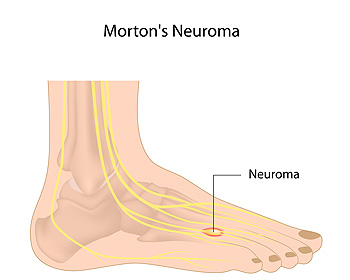 The medical condition that is known as Morton’s neuroma refers to a pinched nerve in the ball of the foot. Pain and discomfort are often felt between the third and fourth toes. The affected nerve can become swollen and is often trapped between the surrounding bones and tissues. The symptoms patients experience can include a numbing or tingling sensation, in addition to swelling between the toes. This condition may gradually develop from wearing shoes that do not have adequate room for the toes to move freely in. Flat feet or high arches may contribute to the onset of Morton’s neuroma, and relief may be found when appropriate shoes are worn. If you are experiencing this type of foot pain, it is suggested that you are under the care of a podiatrist who can help you to manage this condition.
The medical condition that is known as Morton’s neuroma refers to a pinched nerve in the ball of the foot. Pain and discomfort are often felt between the third and fourth toes. The affected nerve can become swollen and is often trapped between the surrounding bones and tissues. The symptoms patients experience can include a numbing or tingling sensation, in addition to swelling between the toes. This condition may gradually develop from wearing shoes that do not have adequate room for the toes to move freely in. Flat feet or high arches may contribute to the onset of Morton’s neuroma, and relief may be found when appropriate shoes are worn. If you are experiencing this type of foot pain, it is suggested that you are under the care of a podiatrist who can help you to manage this condition.
Morton’s neuroma is a very uncomfortable condition to live with. If you think you have Morton’s neuroma, contact Dr. Yeon A. Shim of Roselle Podiatry Group. Our doctor will attend to all of your foot care needs and answer any of your related questions.
Morton’s Neuroma
Morton's neuroma is a painful foot condition that commonly affects the areas between the second and third or third and fourth toe, although other areas of the foot are also susceptible. Morton’s neuroma is caused by an inflamed nerve in the foot that is being squeezed and aggravated by surrounding bones.
What Increases the Chances of Having Morton’s Neuroma?
- Ill-fitting high heels or shoes that add pressure to the toe or foot
- Jogging, running or any sport that involves constant impact to the foot
- Flat feet, bunions, and any other foot deformities
Morton’s neuroma is a very treatable condition. Orthotics and shoe inserts can often be used to alleviate the pain on the forefront of the feet. In more severe cases, corticosteroids can also be prescribed. In order to figure out the best treatment for your neuroma, it’s recommended to seek the care of a podiatrist who can diagnose your condition and provide different treatment options.
If you have any questions, please feel free to contact our office located in Roselle, NJ . We offer the newest diagnostic and treatment technologies for all your foot care needs.
Morton’s Neuroma and the Ball of the Foot
 The medical condition that is known as Morton’s neuroma refers to a pinched nerve in the ball of the foot. Pain and discomfort are often felt between the third and fourth toes. The affected nerve can become swollen and is often trapped between the surrounding bones and tissues. The symptoms patients experience can include a numbing or tingling sensation, in addition to swelling between the toes. This condition may gradually develop from wearing shoes that do not have adequate room for the toes to move freely in. Flat feet or high arches may contribute to the onset of Morton’s neuroma, and relief may be found when appropriate shoes are worn. If you are experiencing this type of foot pain, it is suggested that you are under the care of a podiatrist who can help you to manage this condition.
The medical condition that is known as Morton’s neuroma refers to a pinched nerve in the ball of the foot. Pain and discomfort are often felt between the third and fourth toes. The affected nerve can become swollen and is often trapped between the surrounding bones and tissues. The symptoms patients experience can include a numbing or tingling sensation, in addition to swelling between the toes. This condition may gradually develop from wearing shoes that do not have adequate room for the toes to move freely in. Flat feet or high arches may contribute to the onset of Morton’s neuroma, and relief may be found when appropriate shoes are worn. If you are experiencing this type of foot pain, it is suggested that you are under the care of a podiatrist who can help you to manage this condition.
Morton’s neuroma is a very uncomfortable condition to live with. If you think you have Morton’s neuroma, contact Dr. Yeon A. Shim of Roselle Podiatry Group. Our doctor will attend to all of your foot care needs and answer any of your related questions.
Morton’s Neuroma
Morton's neuroma is a painful foot condition that commonly affects the areas between the second and third or third and fourth toe, although other areas of the foot are also susceptible. Morton’s neuroma is caused by an inflamed nerve in the foot that is being squeezed and aggravated by surrounding bones.
What Increases the Chances of Having Morton’s Neuroma?
- Ill-fitting high heels or shoes that add pressure to the toe or foot
- Jogging, running or any sport that involves constant impact to the foot
- Flat feet, bunions, and any other foot deformities
Morton’s neuroma is a very treatable condition. Orthotics and shoe inserts can often be used to alleviate the pain on the forefront of the feet. In more severe cases, corticosteroids can also be prescribed. In order to figure out the best treatment for your neuroma, it’s recommended to seek the care of a podiatrist who can diagnose your condition and provide different treatment options.
If you have any questions, please feel free to contact our office located in Roselle, NJ. We offer the newest diagnostic and treatment technologies for all your foot care needs.
Read more about Morton's NeuromaFoot Massages During Pregnancy
 Many women experience changes in their feet throughout their pregnancy. Swollen feet is one of the common side effects of pregnancy, and it can occur as a result of the growing fetus and other hormonal changes. Research has indicated that mild relief be found when having frequent foot massages are performed. There are several benefits that are associated with this type of therapy. These can include invoking a peaceful feeling, as well as creating increased blood circulation. If you would like additional information about how foot massages can help during pregnancy, it is suggested that you consult with a podiatrist.
Many women experience changes in their feet throughout their pregnancy. Swollen feet is one of the common side effects of pregnancy, and it can occur as a result of the growing fetus and other hormonal changes. Research has indicated that mild relief be found when having frequent foot massages are performed. There are several benefits that are associated with this type of therapy. These can include invoking a peaceful feeling, as well as creating increased blood circulation. If you would like additional information about how foot massages can help during pregnancy, it is suggested that you consult with a podiatrist.
Pregnant women with swollen feet can be treated with a variety of different methods that are readily available. For more information about other cures for swollen feet during pregnancy, consult with Dr. Yeon A. Shim from Roselle Podiatry Group. Our doctor will attend to all of your foot and ankle needs.
What Foot Problems Can Arise During Pregnancy?
One problem that can occur is overpronation, which occurs when the arch of the foot flattens and tends to roll inward. This can cause pain and discomfort in your heels while you’re walking or even just standing up, trying to support your baby.
Another problem is edema, or swelling in the extremities. This often affects the feet during pregnancy but tends to occur in the later stages.
How Can I Keep My Feet Healthy During Pregnancy?
- Wearing orthotics can provide extra support for the feet and help distribute weight evenly
- Minimize the amount of time spent walking barefoot
- Wear shoes with good arch support
- Wear shoes that allow for good circulation to the feet
- Elevate feet if you experience swelling
- Massage your feet
- Get regular, light exercise, such as walking, to promote blood circulation to the feet
If you have any questions please feel free to contact our office located in Roselle, NJ. We offer the newest diagnostic and treatment technologies for all your foot and ankle needs.
Read more about Foot Care for Pregnant Women
